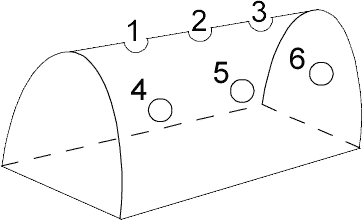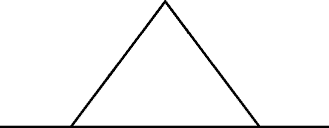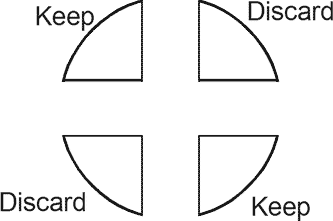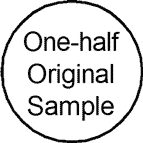
why test feeds | what causes nutrient concentration to vary | what feeds should be analyzed | interpreting test results | sampling feeds for analyses | sample handling
Nutrient concentration can vary considerably in feeds, especially forages. Protein in alfalfa hay can range from 10 to 25 percent or more of the dry matter; grass hay will contain between four and 18 percent protein.
Feed testing can help when identifying certain feeds for different livestock. Feed high quality forage to the most productive livestock or when nutrient needs are highest. Feed lower quality forage to animals with lower nutrient needs.
Feed tests can help establish the dollar value of a forage in the cash market or in personal use inventories. Use these tests to establish the value of a forage and to help determine what forages to feed, buy, or sell.
Forage tests are useful to evaluate production practices like fertilization, time of harvest, method of harvest, etc., that may influence forage quality. Management skills can improve by learning how changes in production practices affect the quality of forages.
Livestock are most productive when fed a ration balanced according to their nutrient needs. Unfortunately, many rations are balanced using average values for each feedstuff. These so-called "book values" often result in over- or under-feeding certain nutrients. More economical and better balanced rations can be formulated using nutrient concentrations determined from feed analysis.
What Causes Nutrient Concentration to Vary?
Plant Species and Variety: Protein concentration, leaf content, fiber, and toxins or other harmful compounds vary among forage plant species and varieties. Alfalfa and other legumes normally are higher in protein and lower in total fiber than grasses.
Annual grasses and some weeds can be high in nitrate content, while sorghum species can accumulate prussic acid. Grains and oilseeds contain little fiber, but high concentrations of starch, protein, and oil (fat).
Maturity: As forage plants mature, fiber concentration increases. Fiber is less digestible than other plant parts, and fiber digestibility declines as plants mature. Both these factors cause the concentration of digestible energy and net energy in plants to decline as they mature. In addition, as plants mature the increase in fiber and bulkiness reduces the amount of the forage an animal can consume. Protein concentration also declines as plants mature.
Leafiness: Leaves contain more protein and digestible energy than stems; stems contain more fiber. The amount of stems relative to leaves increases as plants mature. This causes some of the increase in fiber and decrease in protein and energy associated with maturity. As a result, harvest and storage conditions that save leaves result in more protein and energy in the forage.
Harvest: Plant cells continue to respire, or breathe, while curing, reducing the digestible energy concentration remaining in the plants. Rain on harvested forage also lowers the concentration of soluble nutrients and increases leaf loss.
Raking or baling dry, shatter-prone hay can cause excessive leaf loss. Management techniques (use of conditioners, drying agents, preservatives, timing of activities) that speed curing, avoid rainfall, and reduce leaf loss produce forage with higher nutritional value.
Storage: Moisture content must be within a specific range for effective storage of most feedstuffs. Hay stored too wet loses energy and dry matter by heating and spoilage.
Excessively moist silage may seep and ferment for an extended period of time, resulting in a loss in soluble nutrients. Excessively dry silage allows mold growth, spoilage, and overheating. Grain may heat, mold and spoil if stored too wet.
Weathering of feed stored outdoors can reduce substantially the concentration of many nutrients. These include many energy compounds, vitamins, and minerals. Outdoor storage also results in wind, shattering, and transportation losses.
Factors such as amount of rainfall, drainage, shape and arrangement of storage packages, and time in storage all affect the amount of losses occurring outdoors.
Environment: Warm temperatures, especially at night, increase metabolism of growing forages. At high temperatures, less of the very digestible carbohydrates is stored in plants. More fiber, which is less digestible, is produced. In contrast, during cool weather, leaves and stems accumulate digestible carbohydrates and proteins, resulting in higher nutritive value.
Plants use sunlight to produce energy compounds. Cloudy, low-light conditions tend to produce forage that is less digestible than forage produced in abundant light.
Soil moisture effects are variable. Slight moisture stress can slow plant maturation and maintain or improve nutritive value. Severe stress may cause plant dormancy and result in high fiber and lower feed value.
Unless major deficiencies are present, soil fertility has little influence on nutritive value. Small changes in mineral content can occur. Increased nitrogen fertility can increase crude protein content and hasten maturity of grasses, but it has little effect on grass digestibility. High nitrogen fertility sometimes increases the nitrate or prussic acid content of plants.
Hail, frost, and other weather events often injure leaves, causing lower feed value. Toxic compounds like prussic acid sometimes increase shortly after stressful weather events.
Miscellaneous Factors: Many plant diseases, weeds, and insects affect nutrient concentration in feedstuffs. Weeds can reduce palatability and lower the quality of milk produced by dairy cattle.
What Feeds Should Be Analyzed?
Analyze all feedstuffs that can substantially influence ration cost or animal performance. Analysis is especially important when potential differences between estimated nutrient composition and actual composition are great.
For example, high moisture feeds such as haylage, silage and high moisture grain always should be analyzed for moisture. This is because moisture is difficult to visually estimate. Without this analysis, the amount of the feed to be included in the ration cannot be accurately determined. Also, high-moisture feeds are more likely to lose nutritional value during storage compared to dry feeds.
Forages: Analysis of forages is important because their nutrient composition varies greatly. Forage analyses are most useful when the forage is to be fed to livestock especially sensitive to nutrient level in the forage, such as lactating dairy cows, young growing livestock, and beef cows nursing calves.
Feed Grains: Periodically analyze the major feed grains for lactating and finishing diets. Rapid feeding and turnover of grains may reduce the value of analyses compared to analysis of long-term supplies. However, analyses completed even after grain is fed can detect seasonal or geographical differences that may influence future purchases or use.
Other Feeds: Test by-product feeds. They often vary considerably in nutrient and moisture content.
Always test non-traditional forages or other feeds not commonly raised or fed, and test feeds produced under adverse weather conditions. These feeds often contain a different nutrient concentration than anticipated.
Feed analyses provide information to permit safe, economical, and productive use of these feeds. Also analyze total mixed rations occasionally to check for proper formulation and mixing.
Methods of Feed Testing
Physical: Sight, smell, and touch are useful, although frequently misleading, indicators of feed value. Stage of maturity at harvest, foreign material or pests, color, and leafiness can be detected visually and provide some limited information on the nutritional value of feed. Musty and foul odors can indicate lower quality due to deterioration in storage. A soft, pliable texture may be desired by some livestock.
Physical evaluations alone rarely are sufficient for predicting eventual animal performance, partly because of the lack of a good means of measuring such qualities as color and leafiness. When physical evaluations are combined with more precise and objective tests, the value and usefulness of feeds can be predicted more reliably.
Chemical: Nutrient analyses most commonly are done by chemically reacting or extracting important compounds in a laboratory and determining their amount in the feed. When representative feed samples are tested chemically, accurate predictions of animal performance usually can be made because the nutrient requirements also were determined using chemically tested feeds.
Near Infrared Reflectance (NIR) Spectroscopy: NIR is a rapid, reliable, low-cost, computerized method to analyze feeds for their nutrient content. It uses near infrared light rather than chemicals to identify important compounds and measure their amount in a sample.
Feeds can be analyzed in less than 15 minutes using NIR, compared to hours or days for chemical methods. This rapid turnaround and the resulting cost savings in labor make NIR an attractive new method of analysis. Because the NIR method is still relatively new, some feeds and certain nutrients cannot be tested by this method.
In Vivo and In Vitro: Digestibility often is determined using in vivo and in vitro methods. In vivo procedures are used only in research because they require test animals, take weeks to run, and are expensive. In vitro procedures are conducted in test tubes that simulate the animal's digestive system, but they also are relatively expensive and take several days to complete.
What Analyses Should be Made?
Nutrients of primary concern in feeding cattle are protein, energy, calcium, phosphorus, vitamin A, and certain trace minerals.
Before testing, compare the cost of analyses to the cost of supplements. Consider the extent of deviation of a nutrient in various samples of feed from average values, and the nutritional importance of this variation. For example, the calcium content of grain is low, and the variability is small; thus the cost of calcium analysis relative to cost of calcium addition is rather high.
Analyses for moisture, protein, and energy are most important. Routine analyses of calcium, phosphorus, vitamins and trace minerals generally are not recommended as a basis for formulating rations. Instead, periodically analyze samples of the total ration for calcium, phosphorus, magnesium, zinc, copper and sulfur. Compare these results to animal requirements to ensure that all nutrient needs are being met.
Sampling: Sampling is the key to accurate feed analyses. Feed tests are useful only when the sample collected closely resembles the feed to be fed. Proper sampling techniques will be addressed in the following section.
Dry matter (DM): Dry matter (DM) is the percentage of feed that is not water. In contrast, moisture is a measure of the amount of water in the feed on an "as is" or "as fed" basis, and is important because moisture dilutes the concentration of all nutrients.
Convert nutrient values to a dry basis to formulate rations. Then convert feeds in the ration obtained from the dry basis to an "as fed" basis to obtain amounts to feed or mix in the ration.
Crude protein (CP): Crude protein (CP) measures both true protein and non-protein nitrogen. Protein supplements often are expensive. Because CP tests are relatively inexpensive, they are justified for the benefits received. However, crude protein is a poor predictor of the productive energy value of a feed.
Insoluble crude protein (ICP): Insoluble crude protein (ICP), acid detergent insoluble nitrogen (ADIN), unavailable nitrogen, and heat-damaged protein all refer to nitrogen (or CP) that has become chemically linked to carbohydrates to form an indigestible compound. The overheating that causes this reaction is most common in silage stored at less than 65 percent moisture and in hay bales or stacks that contain more than 20 percent moisture.
Heat-damaged feeds often have an amber, tobacco brown, or charcoal discoloration and a caramelized odor, but sometimes no discoloration occurs. Some ICP normally is present in feeds.
When the ICP/CP ratio is above 0.1, excessive heating probably has occurred, causing reduced protein digestibility. When this occurs, crude protein values should be adjusted downward to more accurately balance rations for protein.
Adjusted crude protein (ACP): Adjusted crude protein (ACP) is a calculated protein value corrected for heat damage. It should be used in place of crude protein to balance rations whenever ICP/CP exceeds 0.1. Most laboratories will compute and report the ACP for forages analyzed for both protein and ICP.
Digestible protein (DP): Digestible protein (DP) is reported by some laboratories. Although potentially useful in specialized situations, nearly all common ration formulations, as well as approved nutrient requirements, are based on crude protein and have been adjusted for digestibility. Do not use DP values except with guidance of a reputable nutritionist.
Crude fiber (CF): Crude fiber (CF) is an old, well-known fiber determination. Newer fiber methods are much more useful measures of nutritional value. Use acid detergent fiber and neutral detergent fiber analyses instead of CF to evaluate forages and formulate rations.
Neutral detergent fiber (NDF): Neutral detergent fiber (NDF) measures the structural part of the plant, the plant cell wall. NDF gives "bulk" or "fill" to the diet, and as a result, limits intake. Because NDF can be used to predict intake, it is one of the most valuable analyses to have conducted on forages for dairy rations, and can be useful for beef rations that rely on forages primarily. Low NDF usually is desired. As maturity of the plant at harvest increases, cell wall content of the plant increases, and NDF increases.
Acid detergent fiber (ADF): Acid detergent fiber (ADF) primarily consists of cellulose, lignin, silica, insoluble crude protein and ash, which are the least digestible parts of the plant. Because ADF percentage in forages negatively relates to digestibility, it is used to calculate energy values. ADF is one of the most common analyses made, particularly on forages. Low ADF usually is preferred because it means higher net energy. As the plant matures, ADF increases.
Digestible dry matter (DDM): Digestible dry matter (DDM) estimates the percentage of forage that is digestible. It is calculated from ADF using the equation:
DDM (%) = 88.9 - [ADF (%) × 0.779]
Net energy (NE): This is the energy available to an animal in a feed after removing the energy lost as feces, urine, gas and heat produced during digestion and metabolism. NE is the most useful energy estimate for formulating rations. The net energy value of a feed depends on whether the feed is used for maintenance (NEm), producing weight gain (NEg), or milk production (NEl). These values are obtained from DDM using formulas shown in Tables I and lI.
Total digestible nutrients (TDN): Total digestible nutrients (TDN) represents the total of the digestible components of crude fiber, protein, fat (× 2.25), and nitrogen-free extract in the diet. This value often is calculated from ADF. It is less accurate than NE for formulating diets containing both forage and grain. Most rations now are formulated using NE; however, TDN is still used to calculate beef cow rations where the diet is primarily forage.
Table I: Estimates of energy values of legumes from ADF %.
ADF |
DDM¹ |
TDN² |
NEl³ |
NEm4 |
NEg5 |
|
(%) |
(%) |
(%) |
----------(Mcal/100 lb)---------- |
||
|
20 |
73 |
77 |
81 |
84 |
56 |
|
22 |
72 |
75 |
78 |
82 |
53 |
|
24 |
70 |
73 |
76 |
78 |
50 |
|
26 |
69 |
71 |
73 |
75 |
48 |
|
28 |
67 |
69 |
71 |
72 |
45 |
|
30 |
66 |
67 |
69 |
69 |
42 |
|
32 |
64 |
64 |
66 |
66 |
40 |
|
34 |
62 |
62 |
64 |
63 |
37 |
|
36 |
61 |
60 |
62 |
60 |
34 |
|
38 |
59 |
58 |
59 |
57 |
31 |
|
40 |
58 |
56 |
57 |
53 |
28 |
|
42 |
56 |
54 |
54 |
50 |
25 |
|
44 |
55 |
52 |
52 |
47 |
22 |
|
46 |
53 |
49 |
50 |
43 |
18 |
|
48 |
52 |
47 |
47 |
40 |
15 |
|
50 |
50 |
45 |
45 |
36 |
12 |
|
52 |
48 |
43 |
43 |
33 |
9 |
|
54 |
47 |
41 |
40 |
29 |
5 |
|
56 |
45 |
39 |
38 |
25 |
2 |
¹DDM = 88.9 - (.779 × ADF).
²TDN = 4.898 + (NEl × .89796).
³NEl = 104.4 - (1.19 × ADF).
4NEm = (137 × ME) - (30.42 × ME²) + (5.1 × ME³) - 50.8.
5NEg = (142 × ME) - (38.36 × ME²) + (5.93 × ME³) - 74.84.
ME = TDN × .01642
Table II: Estimates of energy value of corn silage from its ADF.
|
ADF |
DDM¹ |
TDN² |
NEl³ |
NEm¹ |
NEg¹ |
|
(%) |
(%) |
(%) |
-------(Mcal/100 lb)------- |
||
|
20 |
73 |
74 |
80 |
78 |
50 |
|
22 |
72 |
72 |
77 |
77 |
49 |
|
24 |
70 |
71 |
75 |
76 |
48 |
|
26 |
69 |
70 |
72 |
75 |
47 |
|
28 |
67 |
68 |
70 |
73 |
46 |
|
30 |
66 |
67 |
67 |
72 |
45 |
|
32 |
64 |
66 |
65 |
71 |
44 |
|
34 |
62 |
64 |
62 |
70 |
43 |
|
36 |
61 |
63 |
60 |
68 |
42 |
|
38 |
59 |
62 |
57 |
67 |
40 |
|
40 |
58 |
60 |
55 |
66 |
39 |
Dry matter intake (DMI): Dry matter intake (DMI) estimates the maximum amount of forage dry matter a cow will eat. It is expressed as a percent of body weight and is calculated from NDF using the equation:
DMI (% of body weight) = 120 NDF %
Relative feed value (RFV): Relative feed value (RFV) combines digestibility and intake into one number for a quick, easy, effective way to evaluate the quality of hays or haylages. It is used primarily with legume or legume/grass forages.
RFV (%) = DDM (%) × DMI (% of BW)
1.29
Relative feed value is most valuable for animals using high-forage rations, such as dairy cows and growing animals, because the RFV provides an index to rank a forage according to its digestible energy intake potential. RFV also has been used widely in hay marketing.
Relationships among RFV, DDM, DMI, NDF and ADF are shown in Table III for alfalfa, along with suggested target livestock to feed the different qualities of forage for greatest return. Note that RFV is only an energy intake index and does not give credit for or estimate the amount of either protein or minerals in the forage. Do not rely on RFV alone to formulate or develop rations.
Table III: Relationships among several estimators of alfalfa quality and suggested livestock uses.
|
Analyses Calculations |
||||||||
|
Uses |
ADF |
NDF |
DDM |
DMI |
RFV |
|||
|
|
------(% of DM)----- |
(% of Body Weight) |
||||||
|
Prime dairy, fresh and high producers |
<31 |
<40 |
>65 |
>3.0 |
>151 |
|||
|
Good dairy, young heifers, excellent for backgrounding |
31-35 |
40-46 |
62-65 |
2.6-3.0 |
125-151 |
|||
|
Good beef, older heifers, marginal for dairy cows |
36-40 |
47-53 |
58-61 |
2.3-3.5 |
103-124 |
|||
|
Maintenance for beef or dry dairy cows |
41-42 |
54-60 |
56-57 |
2.0-2.2 |
87-102 |
|||
|
Poor quality* |
43-45 |
61-65 |
53-55 |
1.8-1.9 |
75-86 |
|||
*Requires supplementation with higher quality (energy) feeds as well as possibly other nutrients for most animals. This quality hay could be fed to dry beef cows under some circumstances.
Minerals
When calcium and phosphorus supplements are needed, or when control of their levels is important, periodically analyze feeds for these elements. An example is the control of calcium and phosphorus levels in the dry cow ration of a dairy herd plagued by milk fever.
Because of low costs of supplementation and the cow's ability to tolerate wide variation in ration calcium and phosphorus levels, routine analyses usually are not justified.
Trace minerals commonly are added as insurance against deficiencies. Because of high cost, trace-mineral analyses are not recommended routinely. However, trace minerals should be checked periodically, or when a specific case suggests the need.
Nitrates and Prussic Acid
Forages that are drought damaged, hailed, stunted, or harvested before maturity may contain high levels of nitrates. Analyze nitrate levels on these forages to determine whether the forage is potentially toxic.
Immature sorghums and sudans and especially the regrowth of previously harvested, stunted forage may have excessively high prussic acid levels. However, prussic acid is rarely a problem in harvested forages. If toxic levels are suspected, an analysis may be helpful.
Accurate feed analyses are needed to balance livestock rations, correctly price hay, formulate least cost supplements, and efficiently allocate homegrown feeds to the proper class of livestock. Sampling is the most important factor affecting accuracy of feed analyses.
The feed value of most forages varies. Therefore, test forages routinely to determine their best and most economical use. With adequate forage testing, the producer can develop an accurate forage inventory which allows him/her to efficiently allocate higher quality forage to high-producing livestock and poorer quality forage to animals at lower levels of production. Because forages are more difficult to sample than grains, this guide emphasizes sampling of hay and silage.
The Sample "Lot"
Samples must closely resemble the entire "lot" of forage. In addition, each sample must represent only one "lot" of forage.
A "lot" of forage consists of forage harvested from one field at the same cutting and maturity within a 48-hour period. It usually contains less than 100 tons of hay. The most important consideration when identifying the "lot" is uniformity. All forage from the same "lot" should be similar for: type of plant(s), field (soil type), cutting date, maturity, variety, weed contamination, type of harvest equipment, weather during growth and harvest, preservatives, drying agents, additives, curing and storage conditions, and pest or disease damage. Variation in any of these characteristics can cause substantial differences in forage feed value. When these characteristics differ, designate and sample a new "lot" of forage.
To identify different "lots" of silage, several small square bales of straw, shredded paper, or even some colored egg cartons can be fed through the blower when the last load from each "lot" is ensiled.
Hay Sampling
Sample baled, long hay after curing, using a core sampler or probe. Such an instrument is essential for sampling. It should penetrate at least 12 to 18 inches into the bale and have an internal diameter of at least 3/8-inch.
Hand samples do not provide consistently reliable results. Sometimes a handful of leaves is collected. More often, leaves are stripped from the stem and left behind. Some labs only accept core samples or will not guarantee results from hand samples. Do not use flakes of hay. A flake may not even represent the bale it was selected from due to internal variation. In addition, flakes are too large to submit for testing and must be reduced in size and subsampled. Both variability and sample size can be reduced by using a core sampler.
Core samplers usually have sharpened or serrated tips. Keep tips sharp to cut through hay to prevent selective sampling. Many core samplers can be operated with an electric drill or a hand brace. Run the drill at slow speeds. High speeds heat the probe and can damage samples.
Square or round bales: Select 20 or more typical bales from each "lot." If the probe is 18 inches long or longer, 15 large round bales should be adequate. Collect one sample from each bale by coring straight in from the center of the end of square bales and from the wrapped circumference of round bales. When sampling hay to be fed, avoid sampling decayed or moldy hay or other portions of hay that will be discarded or would likely be refused when fed to animals free choice. However, include deteriorated materials if the hay will be ground, sold or purchased in order to best describe all the hay. Place the entire sample into a plastic bag and seal tightly.
Loose or compressed hay stacks: Use a hay probe at least 24 inches long to collect 15 or more samples from each "lot." Sample loose hay stacks from the top and from the side. Compressed loaf stacks require six sampling locations: 1) top front, 2) top middle, 3) top rear, 4) lower front side, 5) lower middle side, and 6) lower rear side (Figure 1).
Figure 1. Sampling compressed hay stacks.

As different stacks are sampled, alternate the two sides and rotate through the six collection locations. Stand on the stack and insert the probe vertically between feet when top samples are collected. When sides are sampled, use a slight downward angle with the probe to avoid sampling parallel to stems in the stack. As with bales, do not sample deteriorated hay unless it is to be ground prior to feeding, sold, or purchased. Place samples into a plastic bag and seal tightly.
Chopped or ground hay: Periodically collect about 10 small samples from each "lot" of hay during grinding and place all the samples into one plastic bag and seal tightly. Sample previously ground or chopped hay beneath the surface. Collect about one-fourth of the samples from the top half of the pile and the rest from the lower half. Avoid allowing fines to sift between fingers.
Silage Sampling
Silage may be sampled either before it enters the silo or when it is fed. Collect some samples at harvest to use for early ration balancing. When forage is properly ensiled, results from fresh samples will agree closely with fermented forage. Collect samples at feeding for the most accurate nutritional information for ration formulation. Avoid rotted or poorly preserved material that will not be fed or consumed if fed. Such material often comes from the top of upright silos or from the shallow end and slopes of horizontal silos.
Harvest (fresh) samples: Collect 20 or more samples periodically from each "lot" of silage. Take periodic samples as loads are brought to the silo, making sure that the container is closed between each sampling to avoid moisture loss. For example, for a large silo, one quart from a load each morning, noon, and afternoon will suffice. Collect at least two gallons of samples and mix well. Subsample using the following procedure:




Upright silos at feeding: Collect 2 to 3 gallons in 1 to 2 quart increments by passing a clean plastic container beneath the chute while unloading. Alternatively, collect 20 handfuls from different sections of the feed-bunks while feeding. Avoid contamination with old feed or supplements. Mix and subsample as described previously.
Horizontal silos: Collect 20 or more grab samples from numerous sites off the exposed face of the silo to represent the entire exposed surface. Sample to the depth that is normally removed during daily feeding. Sampling from the bunk may be easier and provide an equally representative sample. Mix and subsample as described previously.
Place samples in polyethylene freezer bags and seal tightly so the laboratory can determine a dry matter concentration similar to that in the sample when collected. Double bag silage samples for extra protection. Use extra caution if subdividing a large hay sample. Subsampling dry hay often results in loss of fines and leaves. Although subsampling of silage and mixed feed is easier, use care to obtain a sample similar to the entire lot of silage.
Freeze samples containing over 15 percent moisture until shipping; store dry samples in a cool location. Avoid direct sunlight and damage to the bags.
Label the bag with owner name, address, lot ID, and type of material. Most testing labs provide a description sheet to report this information and to request the desired tests. If the local lab does not have a description sheet, clearly state what tests are desired. Mail or deliver samples so they arrive at the laboratory in mid-week to avoid weekend delays. Ship bags and description sheets in rigid cardboard boxes to reduce chances of damaging the bag.
Ivan G. Rush, Beef Specialist
University of Nebraska
Panhandle Research and Extension Center